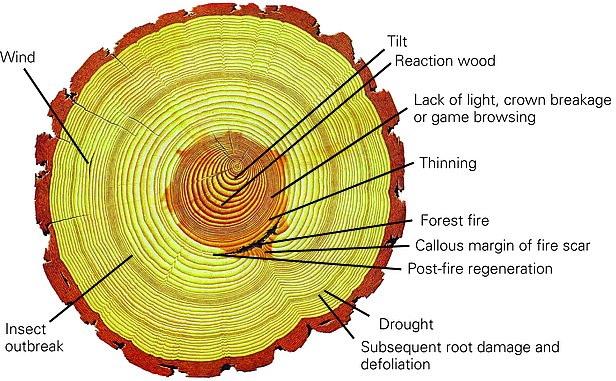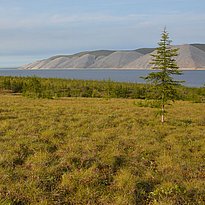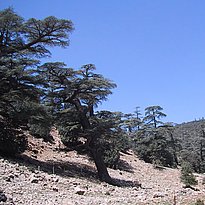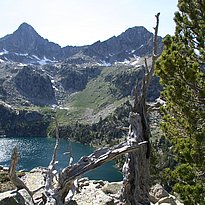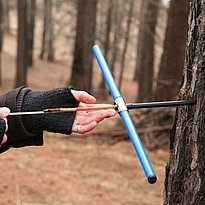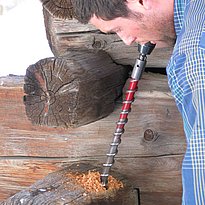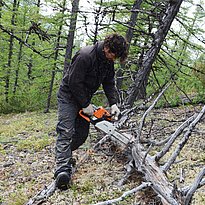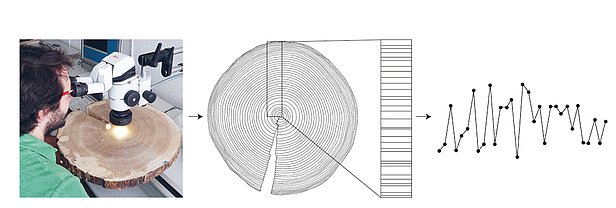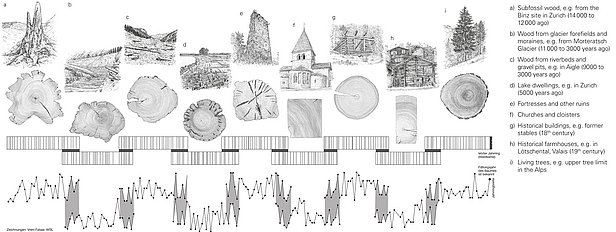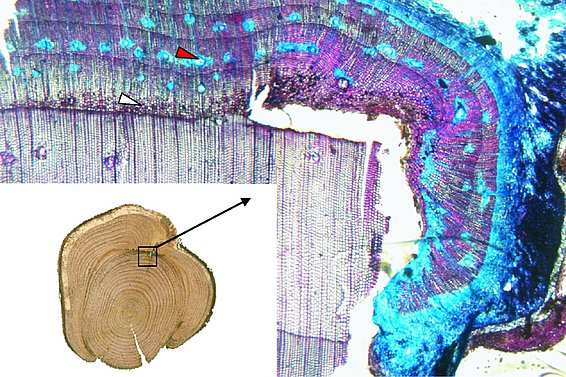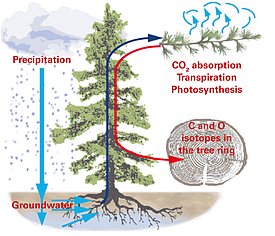¶
Dendrochronology (a word derived from Greek dendron, "tree limb"; khronos, "time"; and -logia, the study of) consists in analyzing tree-ring patterns in order to identify and date past disturbances such as rockfall events, wildfires or snow avalanches as well as past climate conditions. This implies far more than just counting tree rings.
Contents ¶
Tree rings as a record of environmental events ¶
Trees react to their environment, and this reaction is reflected in their growth rings. One example of this is the information the width of tree rings gives us about climate effects. In addition to climate, tree growth may be impacted by insect attacks, fire, rockfalls, wind, avalanches or game browsing (i.e., damage caused by wildlife feeding on tree shoots). Exposure to increased light, for example, when a neighboring tree dies, may also lead to increased ring growth
Searching for wood ¶
Tree-ring research takes the WSL scientists far beyond Switzerland's borders as they travel around the globe to investigate trees and their growth.
Climate reconstructions based on tree rings play a central role in WSL's work. To this end, researchers collect wood samples from locations where tree growth is primarily limited by a single climate factor. For instance, temperature is the limiting factor on tree growth at the alpine tree line and at high latitudes, while in dry regions water availability limits growth.
WSL scientists' search for samples takes them to environments as diverse as the Siberian tundra, the Atlas Mountains in Morocco, and the upper tree line of the Spanish Pyrenees, to name a few examples.
Sampling the most diverse wood types ¶
Dendrochronologists are not only interested in living trees, but also draw on many other sources to gather suitable material for their work. This includes collecting wood from historical buildings or "subfossil" samples preserved for thousands of years in loam soil, bogs and lakes. Samples are either cores removed using special-purpose increment borers or stem discs taken using hand or chainsaws.
Laboratory investigations ¶
First, the surface of each sample is sanded or precisely cut so that all rings and even wood cells are clearly visible. The width of the individual tree rings is then measured with the aid of a microscope. This results in a curve showing the age of the tree and its growth over time, which then forms the basis for dating.
Crossdating: assembling the puzzle ¶
By combining data from living trees with measurements from trees that grew long ago, and whose stems have for instance been incorporated into houses or have trapped in bogs, researchers can draw conclusions about the environmental conditions of the last millennia.
For this purpose, they match growth patterns in tree rings from different wood samples. The individual tree-ring patterns are then correlated with each other, to ensure that all rings are assigned the correct calendar date. This process is known as crossdating. By putting together these exactly crossdated tree-ring series, a tree-ring chronology is established.
Such chronologies can be used as a point of reference for dating historical tree samples.
Ring width and density ¶
At the start of the growing season, conifers form earlywood cells, while at the end they produce smaller (latewood) cells, with thicker walls. The earlywood/latewood ratio reveals the growth conditions. Analysis of the maximum latewood density allows exact conclusions to be drawn about past temperature conditions.
Ring width and maximum latewood density thus act as an indirect temperature gauge and are absolutely key to understand climate prior to the start of instrumental measurements – an internationally important research endeavour. Indeed, WSL has been measuring both of these parameters since the 1970s.
Wood anatomy ¶
The development of wood's anatomical properties depends on environmental conditions. Therefore, changes in light, temperature or precipitation lead to variations in cell size and cell-wall thickness, and sudden events such as avalanches, mudslides and landslides also leave a clear mark in wood tissue.
Wood cuts, thinner than a human hair, are examined under a microscope to date these effects in most cases to the exact season. However, the reason for the scar cannot always be established with complete certainty.
(Figure on the left) In this stem disc from a chestnut tree, an overgrown scar can be seen. At 40x magnification, the initial emergence of the wound tissue can be traced back to the start of the tree ring, in other words this wound occurred in early in the growing season.
As the sample comes from a fire-damaged area, this is very likely to be a fire scar, but in another context, a rockfall could have caused such a scar.
Isotope ratios ¶
Light and heavy atoms of the same chemical element, and specifically the stable isotopes of the elements (C) and oxygen (O), are often measured in tree rings.
Annual variations in isotope ratios provides information on the interactions of physiological and environmental processes, for instance about how trees regulated CO2 absorption and the evaporation of water (transpiration) through the stomata in their leaves and needles.
In contract, measurements of the unstable isotope 14C enables historical, archaeological and subfossil wood to be dated – so called radiocarbon dating.
WSL has a dedicated lab for stable isotope analysis of organic materials, including tree-rings.
Contacts ¶
Services and products ¶
Multimedia ¶
Lötschental - The Observatory of Tree Growth

